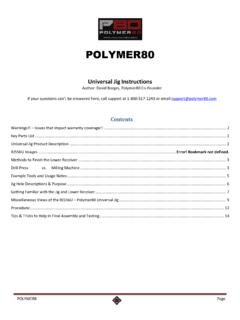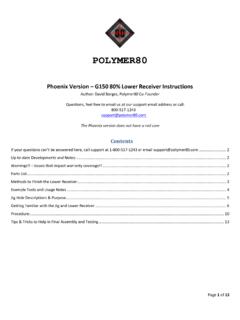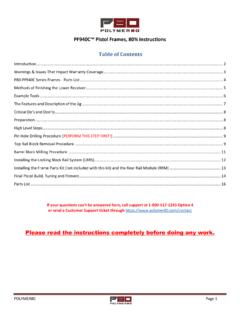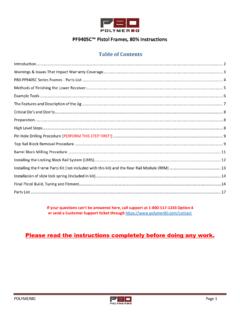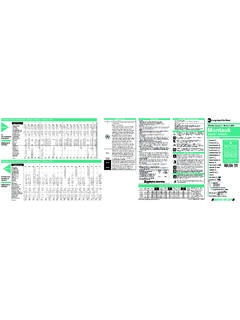Transcription of PF940V2 Pistol Frames, 80% Instructions
1 PF940V2 Pistol Frames, 80% Instructions Table of Contents Introduction .. 2. Warnings & Issues That Impact Warranty 3. P80- PF940V2 Series Frames - Parts List .. 4. Methods of Finishing the Lower Receiver:.. 5. Example Tools .. 6. The Features and Description of the Jig .. 7. Critical Do's and Don'ts .. 8. Preparation .. 8. High Level Steps .. 8. Pin Hole Drilling Procedure (PERFORM THIS STEP FIRST!) .. 9. Top Rail Block Removal Procedure .. 9. Barrel Block Milling Procedure .. 11. Installing the Locking Block Rail System (LBRS) .. 12. Installing the Frame Parts Kit (not included with this kit) and the Rear Rail Module (RRM) .. 13. Final Pistol Build, Tuning and 14. Parts List ..16. If your questions can't be answered here, call support at 1-800-517-1243 Option 4. or send a Customer Support ticket through Please read the Instructions completely before doing any work. POLYMER80 Page 1. Introduction Thanks for choosing our products, we appreciate your business.
2 Polymer80 products are designed with quality in mind, but also with the idea that this should be a fun experience. The Polymer80 Pistol frame that you build will be the pride and joy of your gun safe because you brought it to life with your own hands. Each time you pick up this firearm, you'll feel a sense of pride and accomplishment. You'll feel quality in the field, a smooth operating Pistol that feels good in the hand, that has the latest in ergonomic features that make you a better shooter with a more accurate gun. It's the best of both worlds, and every person here at Polymer80 absolutely believes this to our core. The following Instructions are designed to work with the PF940V2 only. The Instructions are critical to understanding the details of how to build the Pistol frame properly. These Instructions override any Polymer80 produced video or any other online videos/reviews, because videos are difficult to update and control in terms of current versioning.
3 Therefore, this is the control document which guarantees you the latest information required to finish your Pistol project properly. These Instructions will guide you through the process of milling and installing the locking block rail system (LBRS). and rear rail module (RRM). There are many different techniques utilized to build our frames but in general. Remember to read these Instructions completely before completing any work. There are key details concerning how to mill and drill in this document that may surprise even the most experienced gunsmith or machinist. Please read the Instructions to ensure your project is completed with quality and satisfaction. Below you can see the Polymer80 PF Series Family photo. POLYMER80 Page 2. Warnings & Issues That Impact Warranty Coverage Polymer80, Inc. stands by our product and offers excellent no-hassle warranty coverage. However, there are limits to coverage, particularly when the customer damages the product through poor craftsmanship or improper control during the milling process, and when they drill holes using the wrong tools.
4 Additionally, after the milling is completed, the build process seems to be where most people get into trouble, particularly during assembly and cleaning. Here are key areas that you need to watch for: 1. Drill the pin holes using our jig, hand drill and a drill press vise. DO NOT use a drill press either with or without a drill press vise or cross slide vise to drill your holes. Testing has shown while using a drill press the bit will not self-center in the jig and will result in poorly placed or irregular pin holes. 2. Only use Loctite that is approved for contact with polymer-based products. Super Glue versions are not to be used on the polymer. 3. Chemicals: Generally, you do not use penetrating lubricants on polymer products, they can damage the material. a. Do not put acetone on the receiver. Acetone will generally instantly destroy, tarnish, or weaken any polymer-based product. b. Many oils are combined with rust penetrants or some other type of penetrant which can damage polymer-based products.
5 Regular gun oil, high quality grease or simple household oils can be used. c. Do not utilize brake cleaner (it has acetone in it) or rust penetrants, they penetrate through polymer. 4. Do not overtighten the jig in any vise, you can adversely adjust placement of holes to the Pistol frame. Pin hole drill placements are critical on the Pistol frame function. Taping the jig closed with Blue painters' tape or black electrical tape also helps hold the jig together. 5. Using a cross slide vise and end mill bit (End mill bit no longer provided) to remove the front and rear tabs to allow for the installation of the Locking Block Rail System (LBRS) and Rear Rail Module (RRM). remains our preferred method. POLYMER80 Page 3. P80-940v2 Series Frames - Parts List Part Description ITEM SKU Qty per Kit PF940V2 Pistol Frame Lower PF80- PF940V2 1. Red Jig for the PF940V2 P80-PG940V2-JIG 1. Locking Block Rail System Pin, 3mm MSC-PFP-PIN-3MM 1.
6 Diameterx25mm long Trigger Mechanism Housing Pin, 3mm diameter MSC-PFP-PIN-3MM 1. x 25mm long pins Locking Block Rail System P80-LBRS940V2 1. Rear Rail Module P80-PFP-940 RRM1 1. M3 Drill Bit For drilling the Trigger MKI-DRILL-M3 1. Mechanism Housing pin hole M4 Drill Bit - For drilling the trigger pin hole MKI-DRILL-M4 1. POLYMER80 Page 4. Methods of Finishing your PF940V2 Receiver: The goal of finishing your PF940V2 receiver is to Execute the following with the assistance of the jig: a. The holes for the pins, on each side of the receiver. b. Remove the barrel block and smooth out the top of the receiver (Start with 220 Sandpaper and work your way up) to allow the barrel and slide fit later in the build process. c. Remove the front and rear tabs to allow for the installation of the Locking Block Rail System (LBRS) and Rear Rail Module (RRM). d. Install the Polymer80 Locking Block Rail System (LBRS) provided with the kit.
7 E. Install the Rear Rail Module provided with the kit. These Instructions will guide you through the process of milling and installing the locking block rail system (LBRS). and rear rail module (RRM). There are many different techniques utilized to build our frames but in general, we will cover utilizing a drill press which has a cross vise installed on the drill press table. We will not go into much detail for those who have milling machines; the assumption is that a user at this level would already have strong milling and technical skills, allowing them to adapt to the following Instructions . Multiple techniques: Different techniques will result in different qualities of finish. The evolution of the milling process has changed over the years. Our preferred method remains to use an end mill (The end mill bit is not included). Again, we prefer you utilize a drill press with a cross vise because it is faster, requires less time to set up, and you have absolutely the most control if you use the cross vise properly.
8 In all cases, use the included jig and drill bits and always level the jig in your vise: Drill the pin holes using our jig, hand drill and a drill press vise. DO NOT use a drill press either with or without a drill press vise or cross slide vise to drill your holes. Testing has shown while using a drill press the bit will not self-center in the jig and will result in poorly placed or irregular pin holes. For finish work, we prefer to use hand tools and sheets of sandpaper (Wet sanding works best, start at 220 grit and work your way up) rather than a Dremel tool for clean up because of the precision control and feel that is required. A Dremel tool in the untrained hands can damage your new build extremely fast. So be careful if you chose to use a different technique. POLYMER80 Page 5. Example Tools Example Tools Additional Information Cross Slide Vise Accurately moves your work in a horizontal and longitudinal for precise positioning Drill Press Vise Holds your work firmly while reducing vibration when drilling Drill Press Ensures the end mill will be held precisely for milling the taps and removing the barrel block area.
9 Level Utilized to ensure the drill press table is flat Sandpaper 220 grit to fine tune milled areas and to clean up any rough edges of the nylon blended polymer utilized in the frame (Wet sanding works best). Bench Vise Utilized to hold the jig in place during the drilling process Hand Drill Used to drill the pin holes Small Hammer and To install the pins Punch Additional tools to help refine the fit and finish of the frame to the slide: Small hand files, flat sharping stone, 220 grit sandpaper to clean up any areas that were left rough cut, or a Dremel tool with fine sanding wheel. POLYMER80 Page 6. The Features and Description of the Jig The Jig features a numerical system with indicators and drill bit sizes imbedded in the jig. There are three holes on each side of the jig. Make sure to use the appropriately sized drill bits that are included to drill the pin holes. The top jig features are designed to guide you. Remove only the exposed frame slide guards shown in green below.
10 You should not cut into the red ABS polymer of the jig along the top of the jig. You will be ONLY removing the green colored areas shown below. If you remove any red, then you are milling outside of the intended areas and will permanently damaging the frame. Be sure the PF940V2 frame is inserted into the jig properly before any drilling and milling procedures are conducted. The large end mill bit is used to clear the temporary rails (Shown in green) along the top and barrel block which is located where the recoil spring assembly will eventually be installed, inside the Pistol frame. POLYMER80 Page 7. Critical Do's and Don'ts 1. Make sure the jig is free of any burrs along the edges of the jig. You may need to remove any rough edges along the jig to ensure the jig closes properly. 2. Drill the pin holes using our jig, hand drill and a drill press vise. DO NOT use a drill press either with or without a drill press vise or cross slide vise to drill your holes.
